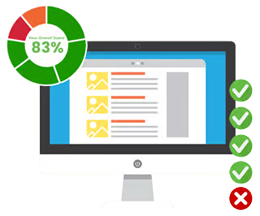What Does UI vs UX Mean?

When it comes to building a website that looks great and works seamlessly, two terms often come up — UI and UX.
They’re closely related, but they describe different aspects of how people interact with your website. Understanding the difference between User Interface (UI) and User Experience (UX) is key to creating a site that not only looks professional but also feels effortless to use.
What Is UI?
UI stands for User Interface — it’s everything the visitor sees and interacts with on your website.
That includes colours, typography, buttons, icons, menus, and layout — essentially, the visual design layer that connects users to your brand and content.
A well-designed UI ensures your site is visually consistent, intuitive, and accessible. It’s about crafting an interface that reflects your brand identity and encourages people to explore confidently.
Strong UI website design focuses on:
- Clear typography and readable text
- Consistent colour palettes and spacing
- Well-placed buttons and navigation menus
- Easy-to-use forms and input fields
- Visual hierarchy — guiding the eye through the page naturally
Example:
Before: A cluttered home page with mismatched fonts, multiple button styles, and hard-to-read text.
After: A clean, consistent layout with defined headings, clear calls-to-action, and colour contrast that meets accessibility standards.
Good UI design makes the first impression. It’s what users notice when they arrive.
What Is UX?
UX stands for User Experience — it’s how someone feels while using your website. UX design goes deeper than visuals; it’s about the journey from start to finish — from finding your website to achieving a goal, like submitting an enquiry or making a purchase.
A strong UX ensures that every step of that journey is logical, enjoyable, and efficient.
Strong UX website design focuses on:
- Understanding user behaviour and goals
- Designing logical navigation and page flow
- Reducing friction (fewer clicks, fewer forms)
- Creating accessible, inclusive pathways
Example:
Before: A website where users can’t find contact details easily, and forms have too many required fields.
After: Clear navigation with a “Contact” button in the main menu, a simple form, and visible confirmation when it’s submitted successfully.
Good UX design builds trust. It’s what users remember when they leave.
How UI and UX Work Together
While UI and UX are different disciplines, they’re inseparable in effective web design.
A website with beautiful visuals (strong UI) but poor usability (weak UX) can frustrate users. Likewise, a website that’s functionally perfect but visually bland can fail to engage.
Example: Navigation Menu Redesign
- UI Perspective: Simplify colours and button styles, increase text contrast for readability.
- UX Perspective: Reorganise menu structure to prioritise high-traffic pages and reduce clicks to key information.
The result? A cleaner, faster experience that looks polished and feels intuitive.
Why UI and UX Matter for Your Website
Accessibility and Inclusivity
UI and UX design both play a role in accessibility — ensuring everyone, including those with visual or motor impairments, can use your website easily. Consistent buttons, sufficient colour contrast, and keyboard-friendly navigation all improve usability.
Conversion and Engagement
Good UX reduces frustration and helps visitors find what they’re looking for faster. Combined with strong UI, this leads to longer engagement, higher conversion rates, and more satisfied users.
Brand Credibility
Your website is often your first interaction with potential clients. A clear, professional UI and smooth UX communicate reliability, attention to detail, and confidence in your services.
When to Review Your UI and UX
If users regularly leave your site quickly, struggle to find information, or abandon forms, it may be time to revisit your design.
Consider reviewing your UI and UX if:
- Your website hasn’t been redesigned in over three years
- You’ve changed your branding or services
- You’re launching new functionality (e.g., online booking systems, e-commerce website)
- You’re receiving support requests from confused users
Final Thoughts
UI and UX are two sides of the same coin — UI shapes the visual experience, while UX shapes the emotional one.
Together, they create a website design that not only looks professional but feels effortless to navigate.
At Web Ideas, our design process integrates both. We combine clean, consistent interfaces with thoughtful user journeys, ensuring every click, scroll, and interaction feels intuitive and purposeful.
If your website looks dated or isn’t performing as it should, talk to us about reviewing its user interface and experience design — small adjustments can make a big difference to usability and engagement.


